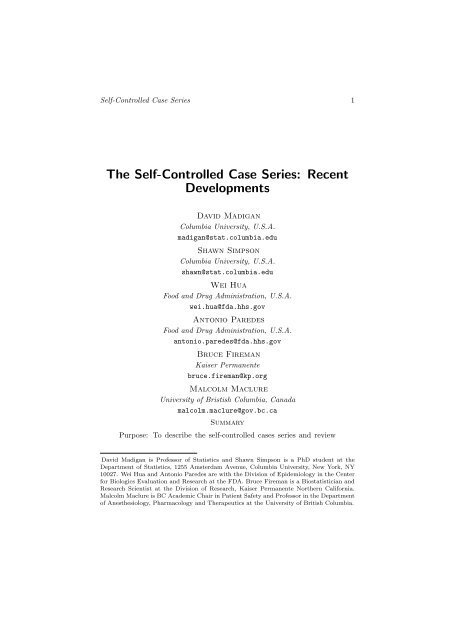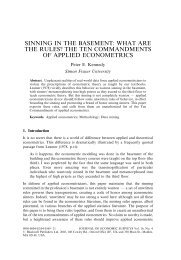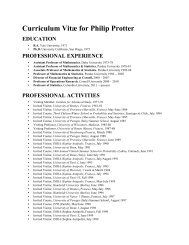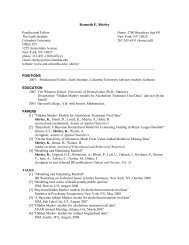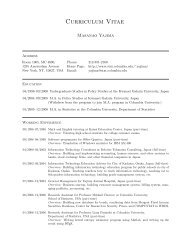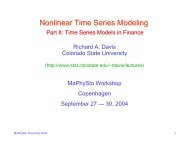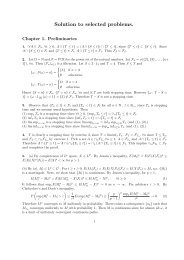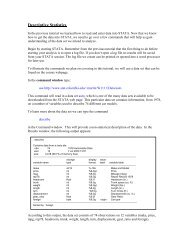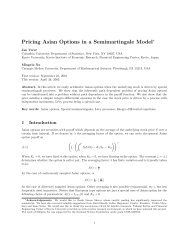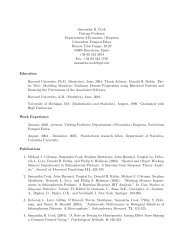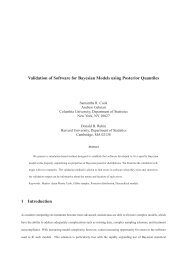The Self-Controlled Case Series - Department of Statistics ...
The Self-Controlled Case Series - Department of Statistics ...
The Self-Controlled Case Series - Department of Statistics ...
Create successful ePaper yourself
Turn your PDF publications into a flip-book with our unique Google optimized e-Paper software.
<strong>Self</strong>-<strong>Controlled</strong> <strong>Case</strong> <strong>Series</strong> 1<br />
<strong>The</strong> <strong>Self</strong>-<strong>Controlled</strong> <strong>Case</strong> <strong>Series</strong>: Recent<br />
Developments<br />
David Madigan<br />
Columbia University, U.S.A.<br />
madigan@stat.columbia.edu<br />
Shawn Simpson<br />
Columbia University, U.S.A.<br />
shawn@stat.columbia.edu<br />
Wei Hua<br />
Food and Drug Administration, U.S.A.<br />
wei.hua@fda.hhs.gov<br />
Antonio Paredes<br />
Food and Drug Administration, U.S.A.<br />
antonio.paredes@fda.hhs.gov<br />
Bruce Fireman<br />
Kaiser Permanente<br />
bruce.fireman@kp.org<br />
Malcolm Maclure<br />
University <strong>of</strong> Bristish Columbia, Canada<br />
malcolm.maclure@gov.bc.ca<br />
Summary<br />
Purpose: To describe the self-controlled cases series and review<br />
David Madigan is Pr<strong>of</strong>essor <strong>of</strong> <strong>Statistics</strong> and Shawn Simpson is a PhD student at the<br />
<strong>Department</strong> <strong>of</strong> <strong>Statistics</strong>, 1255 Amsterdam Avenue, Columbia University, New York, NY<br />
10027. Wei Hua and Antonio Paredes are with the Division <strong>of</strong> Epidemiology in the Center<br />
for Biologics Evaluation and Research at the FDA. Bruce Fireman is a Biostatistician and<br />
Research Scientist at the Division <strong>of</strong> Research, Kaiser Permanente Northern California.<br />
Malcolm Maclure is BC Academic Chair in Patient Safety and Pr<strong>of</strong>essor in the <strong>Department</strong><br />
<strong>of</strong> Anesthesiology, Pharmacology and <strong>The</strong>rapeutics at the University <strong>of</strong> British Columbia.
2 D. Madigan et al.<br />
recent related methodological developments.<br />
Methods: Literature review.<br />
Results: <strong>The</strong> self-controlled case series <strong>of</strong>fers several advantages<br />
for active surveillance for drug safety but we also outline some key<br />
limitations. We describe approaches for addressed some <strong>of</strong> these<br />
limitations.<br />
Conclusions: <strong>The</strong> self-controlled case series model and its extensions<br />
may prove to be a useful tool for active surveillance.<br />
Conflicts <strong>of</strong> Interest: None<br />
Word Count: 3912<br />
Key Points<br />
• <strong>The</strong> self-controlled case series (SCCS) represents one particular<br />
methodology that may be useful for active surveillance<br />
<strong>of</strong> drug safety.<br />
• SCCS has strengths and weaknesses.<br />
• Modifications <strong>of</strong> the basic model can address some but not<br />
all <strong>of</strong> the weaknesses.<br />
• Further research is required to establish the operating characteristics<br />
<strong>of</strong> SCCS-based active surveillance.<br />
Keywords and Phrases: Drug safety; Shrinkage; Poisson<br />
regression; <strong>Case</strong> series;<br />
1. INTRODUCTION<br />
Increasing scientific, regulatory and public scrutiny focuses on the obligation<br />
<strong>of</strong> the medical community, pharmaceutical industry and health authorities to<br />
ensure that marketed drugs have acceptable benefit-risk pr<strong>of</strong>iles. This is an<br />
intricate and ongoing process that begins with carefully designed randomized<br />
clinical trials prior to approval but continues after regulatory market authorization<br />
when the drug is in widespread clinical use. In the post-approval<br />
environment, surveillance schemes based on spontaneous reporting systems<br />
(SRS) represent a cornerstone for the early detection <strong>of</strong> novel drug hazards.<br />
Key limitations <strong>of</strong> SRS-based pharmacovigilance include under-reporting, duplicate<br />
reporting, and the absence <strong>of</strong> a denominator or control group to provide<br />
a comparison.<br />
Newer data sources have emerged that overcome some <strong>of</strong> the SRS limitations<br />
but present methodological and logistical challenges <strong>of</strong> their own.
<strong>Self</strong>-<strong>Controlled</strong> <strong>Case</strong> <strong>Series</strong> 3<br />
Longitudinal observational databases (LODs) provide time-stamped patientlevel<br />
medical information, such as periods <strong>of</strong> drug exposure and dates <strong>of</strong> diagnoses.<br />
Typical examples include medical claims databases and electronic<br />
health record systems. <strong>The</strong> scale <strong>of</strong> some <strong>of</strong> these databases presents interesting<br />
computational challenges – the larger claims databases contain upwards<br />
<strong>of</strong> 50 million lives with up to 10 years <strong>of</strong> data per life. A nascent literature on<br />
risk identification and refinement in LODs now exists including adaptations<br />
<strong>of</strong> some <strong>of</strong> the Bayesian methods developed in the SRS context.<br />
In this paper we consider one particular approach, the self-controlled case<br />
series. We present a Bayesian analysis <strong>of</strong> this method and provide an overview<br />
<strong>of</strong> some recent related developments.<br />
2. LONGITUDINAL OBSERVATIONAL DATABASES<br />
Figure 1: A longitudinal observational dataset with three patients, three distinct<br />
drugs (A, B, and C) and two distinct outcome events (X and O)<br />
Figure 1 provides a schematic <strong>of</strong> LOD data for coverage periods for three<br />
patients. Patient 1 was exposed to drug A during two separate exposure periods.<br />
While on drug A, patient 1 experienced outcome event X on three<br />
different occasions. Patient 2 was exposed to drugs A, B, and C during successive<br />
non-overlapping eras. Patient 2 experienced outcome event X before<br />
consuming any drugs and also experienced outcome event X while consuming<br />
drug C. Patient 3 was exposed to drug C and later starting taking drug B in<br />
addition to drug C. This patient experienced outcome event O while taking<br />
both B and C and later experienced outcome events O and X after the drug B<br />
and C eras had ended. We note that LODs generally provide drug prescription<br />
dates so that construction <strong>of</strong> drug “eras” involves subtle decisions concerning<br />
gaps between successive prescriptions as well as <strong>of</strong>f-drug risk periods. With<br />
outcome events, we think <strong>of</strong> outcomes as occurring at points in time whereas<br />
in truth outcomes are processes spread out in time.<br />
<strong>The</strong> methodological challenge is to estimate the strength <strong>of</strong> the association<br />
between each drug and each outcome event, while appropriately accounting<br />
for covariates such as other drugs and outcome events, patient demographics,<br />
etc.<br />
In this context, several papers have looked at vaccine safety, for example,<br />
Lieu et al. (2007), McClure et al. (2008), and Walker (2009). <strong>The</strong> Vaccine
4 D. Madigan et al.<br />
Safety Datalink provides an early example <strong>of</strong> a LOD specifically designed for<br />
safety. Papers focusing on drug safety include Curtis et al. (2008), Jin et al.<br />
(2008), Kulldorff et al. (2008), Li (2009), Noren et al. (2008), and Schneeweiss<br />
et al. (2009).<br />
3. THE SELF-CONTROLLED CASE SERIES METHOD<br />
Farrington (1995) proposed the self-controlled case series (SCCS) method in<br />
order to estimate the relative incidence <strong>of</strong> adverse events to assess vaccine<br />
safety. <strong>The</strong> major features <strong>of</strong> SCCS are that (1) it automatically controls for<br />
time-fixed covariates that don’t vary within a person during the study period,<br />
and (2) only cases (individuals with at least one event) need to be included<br />
in the analysis. With SCCS, each individual serves as their own control. In<br />
other words, SCCS compares outcome event rates during times when a person<br />
is exposed versus outcome event rates during times when the same person is<br />
unexposed. In effect, the cases’ unexposed time lets us infer expectations<br />
about what would have happened during their exposed time had they not<br />
been exposed.<br />
SCCS is one <strong>of</strong> several self-controlled methods that the epidemiology literature<br />
describes, many <strong>of</strong> which are variants on the case-crossover method<br />
(Maclure, 1991). However unlike the case-crossover method, which typically<br />
requires the choice <strong>of</strong> a comparator time period to serve as a control, SCCS<br />
makes use <strong>of</strong> all available temporal information without the need for selection.<br />
Epidemiological applications <strong>of</strong> SCCS tend to focus on situations with<br />
small sample sizes and few exposure variables <strong>of</strong> interest. In contrast, the<br />
problem <strong>of</strong> drug safety surveillance in LODs must contend with millions <strong>of</strong><br />
individuals and millions <strong>of</strong> potential drug exposures. <strong>The</strong> size <strong>of</strong> the problem<br />
presents a major computational challenge – ensuring the availability <strong>of</strong> an<br />
efficient optimization procedure is essential for a feasible implementation.<br />
3.1. One drug, one adverse event<br />
We will first focus on the case where there is one drug (e.g. Vioxx) and one<br />
adverse event (e.g. myocardial infarction, MI) <strong>of</strong> interest.<br />
To set up the notation, i will index individuals from 1 to N. Events and<br />
exposures in our databases are recorded with dates, so temporal information<br />
is available down to the level <strong>of</strong> days (indexed by d). Let τ i be the number <strong>of</strong><br />
days that person i is observed, with (i,d) being their dth day <strong>of</strong> observation.<br />
<strong>The</strong> number <strong>of</strong> events on day (i,d) is denoted by y id , and drug exposure is<br />
indicated by x id , where x id = 1 if i is exposed to the drug on (i,d), and 0<br />
otherwise.<br />
SCCS assumes that AEs arise according to a non-homogeneous Poisson<br />
process, where the underlying event rate is modulated by drug exposure. We
<strong>Self</strong>-<strong>Controlled</strong> <strong>Case</strong> <strong>Series</strong> 5<br />
will start with the simple assumption that person i has their own individual<br />
baseline event rate e φi , which is constant over time. Under the SCCS model,<br />
drug exposure yields a multiplicative effect <strong>of</strong> e β on the baseline incidence<br />
rate. In other words, the event intensity for person i on day d can be written<br />
as a function <strong>of</strong> drug exposure x id .<br />
λ id = e φi+βx id<br />
<strong>The</strong> number <strong>of</strong> events observed on (i,d) given the current exposure status is<br />
distributed as a Poisson random variable with rate λ id , which has the following<br />
density:<br />
P (y id | x id ) = e−λ id<br />
λ y id<br />
id<br />
y id !<br />
<strong>The</strong> SCCS likelihood contribution for person i is the joint probability <strong>of</strong><br />
the observed sequence <strong>of</strong> events, conditional on the observed exposures<br />
∏τ i<br />
L c i = P (y i1 , . . . , y iτi | x i1 , . . . , x iτi ) = P (y i | x i ) = P (y id | x id )<br />
<strong>The</strong>re are two assumptions implicit in the Poisson model that allow us to<br />
write out this likelihood:<br />
d=1<br />
(i) events are conditionally independent given exposures<br />
y id ⊥ y id ′ | x i for d ≠ d ′ , and<br />
(ii) past events are conditionally independent <strong>of</strong> future exposures given the<br />
current exposure<br />
y id ⊥ x id ′ | x id for d ≠ d ′ .<br />
<strong>The</strong>se assumptions are likely to be violated in practice (e.g., one might<br />
expect that having an MI increase the future risk <strong>of</strong> an MI and also impacts<br />
future drug usage), however they allow for simplifications in the model.<br />
At this point one could maximixe the full log-likelihood over all individuals<br />
(l c = ∑ i log Lc i ) in order to estimate the parameters. However since our primary<br />
goal is to assess drug safety, the drug effect β is <strong>of</strong> primary interest and<br />
the person-specific φ i effects are nuisance parameters. A further complication<br />
is that claims databases can contain well over 10 million patients. Since the dimension<br />
<strong>of</strong> the vector <strong>of</strong> person-specific parameters φ = (φ 1 , . . . , φ N ) ′ is equal<br />
to the number <strong>of</strong> individuals N, estimation <strong>of</strong> φ would call for optimization<br />
in an ultra high-dimensional space and presumably would be computationally<br />
prohibitive.
6 D. Madigan et al.<br />
In order to avoid estimating the nuisance parameter, we can condition on<br />
its sufficient statistic and remove the dependence on φ i . Under the Poisson<br />
model this sufficient statistic is the total number <strong>of</strong> events person i has over<br />
their entire observation period, which we denote by n i = ∑ d y id. For a<br />
non-homogeneous Poisson process, n i is a Poisson random variable with rate<br />
parameter equal to the cumulative intensity over the observation period:<br />
∑τ i<br />
∑τ i<br />
n i | x i ∼ Poisson( λ id = e φi<br />
e βx id<br />
)<br />
d=1<br />
In our case the cumulative intensity is a sum (rather than an integral)<br />
since we assume a constant intensity over each day. Conditioning on n i yields<br />
the following likelihood for person i:<br />
L c i = P ( y i | x i , n i ) = P ( y τ<br />
i | x i )<br />
i<br />
P ( n i | x i ) ∝ ∏<br />
d=1<br />
d=1<br />
( e<br />
βx id<br />
) yid<br />
∑<br />
d e βx ′ id ′<br />
Notice that because n i is sufficient, the individual likelihood in the above<br />
expression no longer contains φ i . This conditional likelihood takes the form<br />
<strong>of</strong> a multinomial, but differs from a typical multinomial regression. Here<br />
the number <strong>of</strong> “bins” (observed days) varies by person, the β parameter is<br />
constant across days, and the covariates x id vary by day.<br />
Assuming that patients are independent, the full conditional likelihood is<br />
simply the product <strong>of</strong> the individual likelihoods.<br />
L c ∝<br />
N∏ ∏τ i<br />
i=1 d=1<br />
( e<br />
βx id<br />
) yid<br />
∑<br />
d e βx ′ id ′<br />
Estimation <strong>of</strong> the drug effect can now proceed by maximizing the conditional<br />
log-likelihood to obtain ˆβ CMLE . Winkelmann (2008) showed that this<br />
estimator is consistent and asymptotically Normal in the Poisson case.<br />
It is clear from the expresson for the likelihood that if person i has no<br />
observed events (y i = 0), they will have a contribution <strong>of</strong> L c i = 1. Consequently,<br />
person i has no effect on the estimation, and it follows that only cases<br />
(n i ≥ 1) need to be included in the analysis.<br />
SCCS does a within-person comparison <strong>of</strong> the event rate during exposure<br />
to the event rate while unexposed, and thus the method is “self-controlled”.<br />
Intuitively it follows that if i has no events, they cannot provide any information<br />
about the relative rate at which they have events. That the SCCS<br />
analysis relies solely on data from cases is a substantial computational advantage<br />
– since the incidence rate <strong>of</strong> most AEs is relatively low, typical SCCS<br />
analyses will utilize only a modest fraction <strong>of</strong> the total number <strong>of</strong> patients .
<strong>Self</strong>-<strong>Controlled</strong> <strong>Case</strong> <strong>Series</strong> 7<br />
3.2. Multiple drug exposures and drug interactions<br />
So far we have discussed the scenario where there is one AE and one drug<br />
<strong>of</strong> interest. However patients generally take multiple drugs throughout the<br />
course <strong>of</strong> their observation period. Additionally, patients may take many<br />
different drugs at the same time point, which leads to a potential for drug<br />
interaction effects. In order to account for the presence <strong>of</strong> multiple drugs and<br />
interactions, the intensity expression for the SCCS model can be extended in<br />
a natural way.<br />
Suppose that there are p different drugs <strong>of</strong> interest, each with a corresponding<br />
exposure indicator x idj = 1 if exposed to drug j on day (i,d); 0<br />
otherwise. Let e βj be the multiplicative effect <strong>of</strong> drug j on the event rate.<br />
A multiplicative model describes the intensity for patient i on day d:<br />
λ id = e φi+β′ x id<br />
= e φi + β1 x id1 + ··· + β p x idp<br />
where x id = (x id1 , . . . , x idp ) ′ and β = (β 1 , . . . , β p ) ′ .<br />
Since n i is still sufficient for φ i , person-specific effects will once again drop<br />
out <strong>of</strong> the likelihood upon conditioning. One can derive the expression in a<br />
similar manner to the previous case <strong>of</strong> one AE and one drug case, resulting<br />
in:<br />
⎡ ⎤<br />
(<br />
)<br />
τ yid i<br />
x<br />
∏<br />
′<br />
L c e β′ x id<br />
i1<br />
i = P ( y i | n i , X i ) ∝ ∑<br />
⎢ ⎥<br />
d=1 d e where X ′ β′ x id ′<br />
i = ⎣ . ⎦<br />
x ′ iτ i<br />
To simplify the summation in the denominator, days with the same drug<br />
exposures can be grouped together. Suppose that there are K i distinct combinations<br />
<strong>of</strong> drug exposures for person i. Each combination <strong>of</strong> exposures defines<br />
an exposure group, indexed by k = 1, . . . , K i .<br />
For person i and exposure group k, we need to know the number <strong>of</strong> events i<br />
has while exposed to k (y ik ) along with the length <strong>of</strong> time i spends in k (l ik ).<br />
For person i we only require information for each <strong>of</strong> K i exposure groups,<br />
rather than for all τ i days. This allows for coarser data and more efficient<br />
storage – since patients tend to take drugs over extended periods <strong>of</strong> time, K i<br />
is typically much smaller than τ i .<br />
L c<br />
∝<br />
N∏<br />
∏K i<br />
i=1 k=1<br />
(<br />
e β′ x ik<br />
∑<br />
k ′ l ik ′e β′ x ik ′<br />
) yik<br />
(1)<br />
SCCS can be further extended to include interactions and time-varying<br />
covariates (e.g. age groups). <strong>The</strong> intensity on (i,d) including two-way drug
8 D. Madigan et al.<br />
interactions and a vector <strong>of</strong> time-varying covariates z id can be written as<br />
λ id = e φi + β′ x id + ∑ r≠s γrs x idr x ids + α ′ z id<br />
where γ denotes a two-way interaction between drugs r and s.<br />
Remark 1. In practice, many adverse effects can occur at most once in<br />
a given day suggesting a binary rather than Poisson model. One can show<br />
that adopting a logistic model yields an identical conditional likelihood to (1).<br />
This equivalence allows shifting to a logistic model with follow-up truncated<br />
at the outcome event, when that event is the onset <strong>of</strong> an enduring condition<br />
that permanently changes exposure propensity (see Discussion below.)<br />
Remark 2. It is straightforward to show that the conditional likelihood<br />
in (1) is log-concave.<br />
3.3. Bayesian <strong>Self</strong>-<strong>Controlled</strong> <strong>Case</strong> <strong>Series</strong><br />
We have now set up the full conditional likelihood for multiple drugs, so one<br />
could proceed by finding conditional maximum likelihood estimates <strong>of</strong> the<br />
drug parameter vector β. However in the problem <strong>of</strong> drug safety surveillance<br />
in LODs there are millions <strong>of</strong> potential drug exposure predictors (tens<br />
<strong>of</strong> thousands <strong>of</strong> drug main effects along with drug interactions). This high<br />
dimensionality leads to potential overfitting under the usual maximum likelihood<br />
approach, so regularization is necessary.<br />
We take a Bayesian approach by putting a prior over the drug effect parameter<br />
vector and performing inference based on posterior mode estimates.<br />
<strong>The</strong>re are many choices <strong>of</strong> prior distributions that shrink the parameter estimates<br />
toward zero and address overfitting. In particular, we focus on the (1)<br />
Normal prior and (2) Laplacian prior.<br />
(i) Normal prior. Here we shrink the estimates toward zero by putting an<br />
independent Normal prior on each <strong>of</strong> the parameter components. Taking<br />
the posterior mode estimates would be analogous to a ridge Poisson<br />
regression, placing a constraint on the L 2 -norm <strong>of</strong> the parameter vector.<br />
(ii) Laplace prior. Under this choice <strong>of</strong> prior a portion <strong>of</strong> the posterior<br />
mode estimates will shrink all the way to zero, and their corresponding<br />
predictors will effectively be selected out <strong>of</strong> the model. This is equivalent<br />
to a lasso Poisson regression, where there is a constraint on the L 1 -norm<br />
<strong>of</strong> the parameter vector estimate.<br />
Efficient algorithms exist for finding posterior modes, rendering our approach<br />
tractable even in the large-scale setting. In particular, we have adapted<br />
the cyclic-coordinate descent algorithm <strong>of</strong> Genkin et al. (2007) to the SCCS<br />
context. An open-source implementation is available at http://omop.fnih.org.
<strong>Self</strong>-<strong>Controlled</strong> <strong>Case</strong> <strong>Series</strong> 9<br />
4. EXTENSIONS TO THE BASIC SCCS MODEL<br />
4.1. Relaxing the Independence Assumptions I: Events<br />
.<br />
Farrington and Hocine (2010) present an approach that extends SCCS to<br />
allow for within-individual event dependence. This method treats the vector<br />
<strong>of</strong> observed event times t i = (t i1 , . . . , t ini ) ′ for each individual i as a single<br />
point in an n i -dimensional region, where n i denotes the number <strong>of</strong> events<br />
experienced by individual i. This region is restricted to Q i (n i ) = {t i ∈<br />
(a i , b i ] ni : t i1 < · · · < t ini } (where (a i , b i ] denotes the observation period for<br />
individual i) since the components <strong>of</strong> t i are ordered by time, and no event<br />
times can occur outside <strong>of</strong> the observation window (a i , b i ]. Standard SCCS<br />
assumes that events are realizations <strong>of</strong> a one-dimensional Poisson process<br />
and conditions upon the observed number <strong>of</strong> events n i . Under Farrington<br />
and Hocine’s model, however, the event time vector t i is treated as a single<br />
point arising from an n i -dimensional Poisson process. In this framework,<br />
conditioning on n i is equivalent to conditioning on the occurrence <strong>of</strong> a single<br />
point in the region Q i (n i ).<br />
If λ i (t 1 , . . . , t ni | x i ) is the intensity <strong>of</strong> the n i -dimensional Poisson process<br />
on Q i (n i ), the conditional likelihood <strong>of</strong> t i given the occurrence <strong>of</strong> one such<br />
point in Q i (n i ) is<br />
L ni<br />
i =<br />
∫<br />
Q i(n i)<br />
λ i (t i1 , . . . , t ini | x i )<br />
(2)<br />
λ i (u 1 , . . . , u ni | x i )du 1 · · · du ni<br />
Farrington and Hocine assume that the n i -dimensional Poisson intensity<br />
can be written in the form<br />
∏n i<br />
λ i (t 1 , . . . , t ni | x i ) = λ i (t j | x i ) × H ni (t 1 , . . . , t ni ) (3)<br />
j=1<br />
where the product term is made up <strong>of</strong> independent univariate intensities<br />
λ i (t | x i ), and the H ni (.) function determines the dependence between events.<br />
From (2) and (3) we can see that terms <strong>of</strong> λ i (t | x i ) that are fixed in time<br />
will cancel out <strong>of</strong> the conditional likelihood, as they do in the original SCCS<br />
model. Similarly, fixed terms <strong>of</strong> H ni (.) will also drop out <strong>of</strong> the conditional<br />
likelihood. Farrington and Hoccine explore different possible choices for H.<br />
4.2. Relaxing the Independence Assumptions II: <strong>The</strong> PD Model<br />
.<br />
<strong>The</strong> PD-SCCS model (Simpson, 2011) extends SCCS to allow positive<br />
dependence between events, meaning that the occurrence <strong>of</strong> an event can
10 D. Madigan et al.<br />
increase an individual’s future event risk. Let N i (t) record the number <strong>of</strong><br />
events that person i has experienced up until time t. Assume, as before, that<br />
i has n i total events during their observation period and that these events<br />
occur at times t i1 < · · · < t ini . It is convenient to define a counting process,<br />
such as N i (t), in terms <strong>of</strong> its intensity function λ i (t | x i (t)). This function<br />
gives the instantaneous probability that an event occurs at time t, given the<br />
history <strong>of</strong> the process and covariates. Under the SCCS model, the Poisson<br />
intensity for i at time t is<br />
λ i (t | x i (t)) = e φi+β′ x i(t)<br />
(4)<br />
as was previously described. PD-SCCS extends this model by incorporating<br />
N i (t − ), the number <strong>of</strong> events that i has experienced up to but not including<br />
time t, as an additive effect on the individual baseline e φi . <strong>The</strong> PD-SCCS<br />
intensity function takes the form<br />
λ i (t | x i (t)) = (e φi + δN i (t − )) e β′ x i(t)<br />
(5)<br />
where δ is the parameter that controls the level <strong>of</strong> dependence between events.<br />
Based on plugging the PD-SCCS intensity (5) into the likelihood expression<br />
for a general intensity-based process, one can see that the total number <strong>of</strong><br />
events n i is sufficient for the nuisance parameter φ i . As in the SCCS model,<br />
conditioning on n i removes φ i from the likelihood expression. Symmetry<br />
arguments yield a closed form for the conditional likelihood, which in the denominator<br />
requires integrating over all possible ways for i to have n i events<br />
during their observation period. Inference for β and δ is based on this conditional<br />
likelihood. Since the intensity function must be non-negative, the<br />
event dependence parameter is restricted to δ > 0. In the case that δ = 0, the<br />
PD-SCCS intensity model in (5) reduces to that <strong>of</strong> the SCCS model in (4).<br />
4.3. Relaxing the Independence Assumptions III: Exposures<br />
.<br />
As discussed above, the SCCS model assumes that events are conditionally<br />
independent <strong>of</strong> subsequent exposures. Farrington et al. (2009) present<br />
an ingenious relaxation <strong>of</strong> this assumption using a counterfactual modeling<br />
approach. <strong>The</strong>ir approach applies to the specific situation where the risk<br />
returns to its baseline level at the end <strong>of</strong> each risk period, where the event<br />
<strong>of</strong> interest is non-recurrent, and where the occurence <strong>of</strong> the event precludes<br />
future exposures.<br />
Here we sketch the Farrington et al. approach using a simplified version <strong>of</strong><br />
their running example. Consider a situation in which each individual can have<br />
up to two exposures. For individual i, again denote by (a i , b i ] the observation<br />
period and denote by c i1 and c i2 the actual exposure times, should they occur.
<strong>Self</strong>-<strong>Controlled</strong> <strong>Case</strong> <strong>Series</strong> 11<br />
For notational simplicity, we consider point exposures followed by some<br />
known increased-risk time. <strong>The</strong> exposures then partition the observation<br />
period into up to five periods indexed by j: a control period, followed by<br />
an increased-risk period, followed by a control period, followed by a second<br />
increased-risk period, followed by a final control period. Denote by n ij the<br />
number <strong>of</strong> events occurring in the jth period, n ij ∈ {0, 1}. Let β 1 and β 2 denote<br />
the log relative incidences associated with the first and second increased<br />
risk periods respectively and denote by T i the event time.<br />
If T i occurs after c i2 then no further exposures can occur and inference<br />
about β 2 can proceed in the usual fashion. Inference for β 1 is more complex<br />
in the situation where the event occurs after just one exposure becuase the<br />
timing <strong>of</strong> the counterfactual second exposure is then unavailable. Farrington<br />
et al. then make the following key observation: suppose, counterfactually,<br />
that no individual experienced a second exposure. <strong>The</strong>n it would be possible<br />
to estimate β 1 without bias. For this to work, we would need to know n ∗ i4 ,<br />
the number <strong>of</strong> events in the fourth period, had no second exposure occurred.<br />
This is missing for those individuals that did in fact have a second exposure.<br />
However, n i4 e −β2 is an unbiased estimate <strong>of</strong> n ∗ i4 for these individuals - this<br />
amounts to backing out the actual elevated risk during the second exposure.<br />
Using n ∗ i4 in place <strong>of</strong> n i4 then leads to an unbiased estimate <strong>of</strong> β 1 .<br />
Farrington et al. present the general case, an associated sandwich estimator<br />
for the variance, and also a computationally efficient equivalent approach<br />
based on pseudo likelihood.<br />
We note that Roy et al. (2006) present an alternative approach.<br />
4.4. Structured SCCS Models<br />
. We are currently exploring several extensions to the basic model.<br />
(i) Hierarchical model: Drugs. Drugs form drug classes. For example,<br />
Vioxx is a Cox-2 inhibitor. Cox-2 inhibitors in turn are non-steroidal<br />
anti-inflammatories. A natural extension assumes regression coefficients<br />
for drugs from within a single class arise exchangeably from a common<br />
prior distribution. This hierarchy could extend to multiple levels.<br />
(ii) Hierarchical model: AEs. AEs also form AE classes. For example, an<br />
MI is a cardiovascular thrombotic (CVT) event, a class that includes, for<br />
example, ischemic stroke and unstable angina. In turn, CVT events belong<br />
to a broader class <strong>of</strong> cardiovascular events. This extension assumes<br />
that the regression coefficients for a particular drug but for different<br />
AEs within a class arise from a common prior distribution. Again this<br />
hierarchy could extend to multiple levels.
12 D. Madigan et al.<br />
5. DISCUSSION<br />
We have described self-controlled case series methods for post-approval drug<br />
safety risk estimation, some Bayesian and some not. Key advantages <strong>of</strong> the<br />
self-controlled case series approach include:<br />
• SCCS adjusts for all time-invariant multiplicative confounders,<br />
• Estimation requires only cases, and<br />
• A regularized/Bayesian implementation <strong>of</strong> SCCS scales to large databases<br />
with the potential to adjust for large numbers <strong>of</strong> time-varying covariates.<br />
<strong>The</strong> main problems with the SCCS approach concern the underlying independence<br />
assumptions, in particular, the assumption that events are conditionally<br />
independent, and the assumption that the exposure distribution and<br />
the observation period must be independent <strong>of</strong> event times. We described<br />
approaches to circumvent these assumptions and these may be useful in some<br />
applications.<br />
Furthermore, since SCCS estimates the exposure-outcome association in<br />
cases, it ignores data on individuals in the study population that did not experience<br />
the outcome event. For example, there may be seasonality driving both<br />
the exposure and the outcome, where season is an important time-varying covariate.<br />
To adjust for seasonality, it is helpful to address both (a) the relation<br />
between season and the exposure, and (b) the relation between season and<br />
the outcome. While SCCS can incorporate time varying covariates, ignoring<br />
Sentinel’s rich data on the non-cases limits our power to address (a). In another<br />
paper in this issue, we discuss how analyses <strong>of</strong> data from non-cases can<br />
supplement case-based analyses<br />
We note that one possible approach to dealing with the exposure independence<br />
issue is to truncate observation time after the first event occurrence.<br />
This violates other SCCS assumptions but may still be useful in practice. Figure<br />
2 shows estimates for a number <strong>of</strong> drug-outcome pairs with and without<br />
truncation. Clearly the truncation does alter some estimated relative risks<br />
substantially and future work will evaluate the empirical performance <strong>of</strong> this<br />
approach.<br />
Real-life LODs are noisy and have the potential to introduce all sorts<br />
<strong>of</strong> artifacts and biases into analyses. For example, conditions and the drugs<br />
prescribed to treat the conditions are <strong>of</strong>ten recorded simultaneously at a single<br />
visit to the doctor, even though the condition actually predated the visit. This<br />
can introduce “confounding by indication” - the drug used to treat a condition<br />
can appear to be caused by the condition. Many such challenges exist and it<br />
remains to be seen whether or not false positives will render risk identification<br />
in LODs impractical.
<strong>Self</strong>-<strong>Controlled</strong> <strong>Case</strong> <strong>Series</strong> 13<br />
Since all methods rely on dubious assumptions, future research will focus<br />
on establishing the operating characteristics <strong>of</strong> competing approaches. <strong>The</strong><br />
Observational Medical Outcomes Partnership (OMOP) has empirically compared<br />
the predictive performance <strong>of</strong> SCCS, multivariate SCCS, and a wide variety<br />
<strong>of</strong> competing methods. Initial results suggest that SCCS is competitive<br />
with other methods and multivariate SCCS is a top performer. Nonetheless,<br />
the performance <strong>of</strong> all methods in OMOP leaves much room for improvement.<br />
REFERENCES<br />
Curtis, J. R., Cheng, H., Delzell, E., Fram, D., Kilgore, M., Saag, K., Yun,<br />
H., and DuMouchel, W. (2008). Adaptation <strong>of</strong> Bayesian data mining<br />
algorithms to longitudinal claims data. Medical Care, 46, 969-975.<br />
Farrington, P. (1995). Relative incidence estimation from case series for<br />
vaccine safety evaluation. Biometrics 51, 228–235.<br />
Farrington, C. P., Whitaker, H. J. and Hocine, M. N. (2009). <strong>Case</strong> series<br />
analysis for censored, perturbed or curtailed post-event exposures.<br />
Biostatistics, 10, 3–16.<br />
Farrington, P. and Hocine, M.N. (2010). Within-individual dependence in<br />
self-controlled case series models for recurrent events. Appl. Statist. 59,<br />
457–475.<br />
Genkin, A., Lewis, D. D., and Madigan, D. (2007) Large-scale Bayesian<br />
logistic regression for text categorization,Technometrics 49, 291–304.<br />
Jin, H., Chen, J., He, H., Williams, G.J., Kelman, C., and OḰeefe, C.M.<br />
(2008). Mining unexpected temporal associations: Applications in<br />
detecting adverse drug reactions. IEEE Transactions on Information<br />
Technology in Biomedicine, 12, 488–500.<br />
Kulldorff, M., Davis, R.L., Kolczak, M., Lewis, E., Lieu, T., and Platt, R.<br />
(2008). A maximized sequential probability ratio test for drug and<br />
vaccine safety surveillance. Preprint.<br />
Li, L. (2009). A conditional sequential sampling procedure for drug safety<br />
surveillance. <strong>Statistics</strong> in Medicine. DOI:10.1002/sim.3689<br />
Lieu, T.A., Kulldorff, M., Davis, R.L., Lewis, E.M., Weintraub, E., Yih, K.,<br />
Yin, R., Brown, J.S., and Platt, R. (2007). Real-time vaccine safety<br />
surveillance for the early detection <strong>of</strong> adverse events. Medical Care, 45,<br />
S89–95.<br />
Maclure, M. (1991). <strong>The</strong> <strong>Case</strong>-Crossover Design: A Method for Studying<br />
Transient Effects on the Risk <strong>of</strong> Acute Events. American Journal <strong>of</strong><br />
Epidemiology, 133, 144–153.<br />
McClure, D. L., Glanz, J. M., Xu, S., Hambidge, S. J., Mullooly, J. P., and<br />
Baggs, J. (2008). Comparison <strong>of</strong> epidemiologic methods for active<br />
surveillance <strong>of</strong> vaccine safety. Vaccine, doi:10:1016/j.vaccine.2008.03.074.
14 D. Madigan et al.<br />
Noren, G. N., Bate, A., Hopstadius, J., Star, K., and Edwards, I. R. (2008).<br />
Temporal pattern discovery for trends and transient effects: its<br />
application to patient records. In: Proceedings <strong>of</strong> the Fourteenth<br />
International Conference on Knowledge Discovery and Data Mining<br />
SIGKDD 2008, 963–971.<br />
Roy, J., Alderson, D., Hogan, J.W., and Tashima, K. T. (2006). Conditional<br />
inference methods for incomplete Poisson data with endogenous<br />
time-varying covariates, J. Amer. Statist. Assoc. 101, 424–434.<br />
Schneeweiss, S., Rassen, J. A., Glynn, R. J., Avorn, J., Mogun, H., and<br />
Brookhart, M. A. (2009). High-dimensional propensity scoring<br />
adjustment in studies <strong>of</strong> treatment effects using health care claims data.<br />
Epidemiology, 20, 512-522.<br />
Simpson, S.E. (2011). <strong>The</strong> positive-dependence self-controlled case series<br />
model. Submitted.<br />
Walker, A. M. (2009). Signal detection for vaccine side effects that have not<br />
been specified in advance. Preprint.<br />
Winkelmann, R. (2008). Econometric Analysis <strong>of</strong> Count Data. Springer.
<strong>Self</strong>-<strong>Controlled</strong> <strong>Case</strong> <strong>Series</strong> 15<br />
Truncated versus Non−Truncated SCCS, log RR<br />
Truncated<br />
−0.4 −0.2 0.0 0.2 0.4 0.6<br />
●<br />
●<br />
true positives<br />
negative controls<br />
Typical Aplastic ●<br />
● Typical Acute Re<br />
Warfarin Hip Frac ●<br />
● Typical Upper GI<br />
●<br />
Tricycli Angioede<br />
●<br />
●<br />
Antibiot Acute Li ●<br />
Typical Acute my<br />
Typical Bleeding<br />
Beta blo Acute my<br />
Antibiot Acute Re<br />
●<br />
●<br />
● Antiepil Aplastic<br />
●<br />
Antibiot Aplastic<br />
●<br />
Warfarin Aplastic<br />
Antibiot Angioede<br />
●<br />
●<br />
Bisphosp Mortalit<br />
●<br />
●<br />
Benzodia Typical Angioede Antibiot Hip Tricycli Frac Acute Upper myGI<br />
Typical Acute Li Tricycli Mortalit Beta blo Mortalit<br />
● ●<br />
●<br />
●<br />
Beta ●<br />
blo Angioede<br />
● ACE Inhi Aplastic<br />
●<br />
●<br />
●<br />
●<br />
●<br />
Amphoter Acute<br />
Amphoter<br />
Li<br />
Upper Warfarin GI Benzodia Acute myMortalit<br />
● Bisphosp Aplastic<br />
Benzodia Acute ● my<br />
Benzodia Bleeding Antiepil Acute Re<br />
●<br />
● Typical Mortalit ● Benzodia Acute Li<br />
Antibiot Bleeding ●<br />
Beta blo Acute Re<br />
Antibiot Upper GI ●<br />
Beta Typical blo Aplastic Angioede ● ●<br />
●<br />
Amphoter Aplastic ●<br />
● ●<br />
●<br />
Warfarin Angioede<br />
Amphoter<br />
● Benzodia<br />
Acute<br />
Upper<br />
ReWarfarin GI<br />
Upper GI<br />
Amphoter Acute my ● ● Antibiot Mortalit<br />
Warfarin Acute Li<br />
●<br />
●<br />
●<br />
Tricycli AplasticAntiepil Mortalit<br />
Beta blo Acute Li<br />
● Tricycli Acute Li ●<br />
● Tricycli Acute my<br />
Amphoter Warfarin BleedingAcute ● Re ● Antiepil Hip Frac ●<br />
●<br />
●<br />
● Tricycli Bleeding Beta blo Upper GI<br />
Antibiot Hip Frac<br />
●<br />
Benzodia Aplastic ●<br />
ACE Inhi Acute Li Bisphosp Acute Li<br />
●Tricycli Benzodia Hip Frac Acute Re<br />
●<br />
Tricycli Acute Re<br />
●<br />
Warfarin Mortalit ●<br />
●<br />
●<br />
● ACE Inhi Upper GI<br />
●<br />
Beta blo Hip Frac<br />
●<br />
Antiepil Angioede ACE Inhi ● Bleeding<br />
Beta blo Bleeding ●<br />
●<br />
ACE Inhi Acute Re Bisphosp ● Acute my<br />
●<br />
Antiepil Acute Li<br />
Bisphosp Hip Frac ●<br />
Bisphosp Acute Re<br />
● Benzodia Hip Frac<br />
●<br />
Bisphosp Angioede<br />
ACE Inhi ● Antiepil Acute my Bleeding ●<br />
Antiepil Upper GI ●<br />
●<br />
Bisphosp Upper GI<br />
● ACE Inhi Hip Frac<br />
●<br />
●<br />
ACE Inhi Mortalit<br />
Bisphosp Bleeding<br />
●<br />
Warfarin Bleeding<br />
●<br />
ACE Inhi Angioede<br />
●<br />
Antiepil Acute my<br />
−0.2 0.0 0.2 0.4 0.6 0.8 1.0<br />
NotTruncated<br />
MSCCSv1.0_MSLR_ctype_2_prior_normal_var_0.1_swindo_n30_ds_1_<br />
Figure 2: Relative risk estimates from SCCS versus truncated SCCS for 53<br />
drug-outcome pairs in the OMOP experiment.


